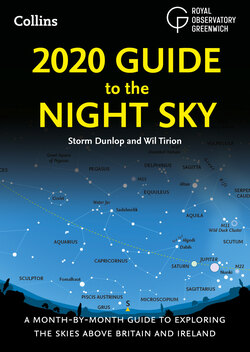Читать книгу 2020 Guide to the Night Sky - Storm Dunlop - Страница 8
ОглавлениеThe Spring Constellations
The most prominent constellation in the spring sky is the zodiacal constellation of Leo, and its brightest star, Regulus (α Leonis), which may be found by extending a line from Megrez and Phecda (δ and γ Ursae Majoris, respectively) – the two stars on the opposite side of the bowl of the Plough from the Pointers – down to the southeast. Regulus forms the ‘dot’ of the ‘backward question mark’ known as ‘the Sickle’. Regulus, like Aldebaran in Taurus, is one of the bright stars that lie close to the ecliptic, and that are occasionally occulted by the Moon. The same line from Ursa Major to Regulus, if continued, leads to Alphard (α Hydrae), the brightest star in Hydra, the largest of the 88 constellations.
The shape formed by the body of Leo is sometimes known as the ‘Spring Trapezium’. At the other end of the constellation from Regulus is Denebola (β Leonis), and the line forming the back of the constellation through Denebola points to the bright star Spica (α Virginis) in the constellation of Virgo. A saying that helps to locate Spica is well known to astronomers: ‘Arc to Arcturus and then speed on to Spica.’ This suggests following the arc of the tail of Ursa Major to Arcturus and then on to Spica. Arcturus (α Boötis) is actually the brightest star in the northern hemisphere of the sky. (Although other stars, such as Sirius, are brighter, they are all in the southern hemisphere.) Overall, the constellation of Boötes is sometimes described as ‘kite-shaped’ or ‘shaped like the letter P’.
Although Spica is the brightest star in the zodiacal constellation of Virgo, the rest of the constellation is not particularly distinct, consisting of a rough quadrilateral of moderately bright stars and some fainter lines of stars extending outwards.
